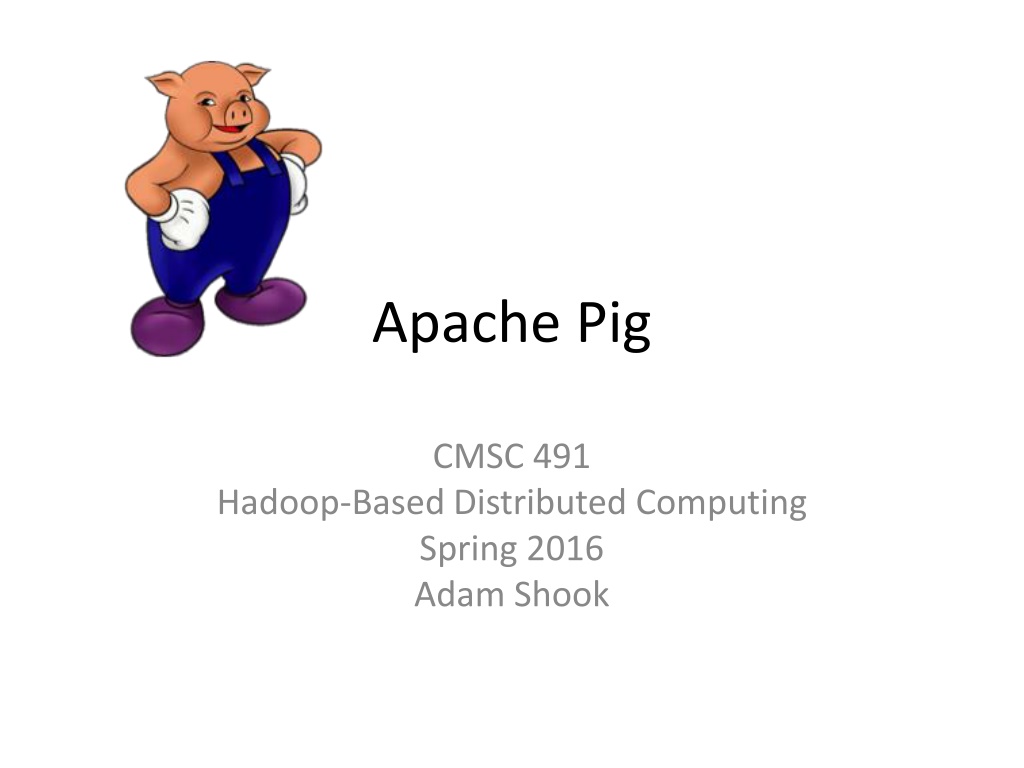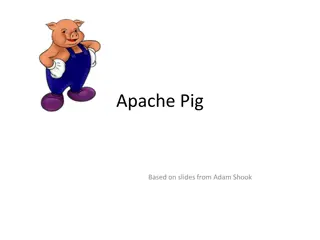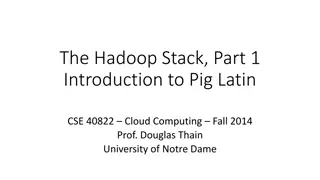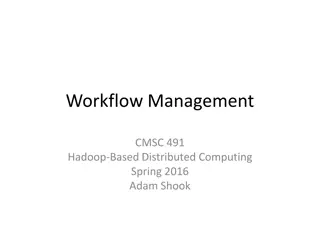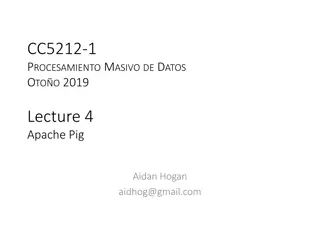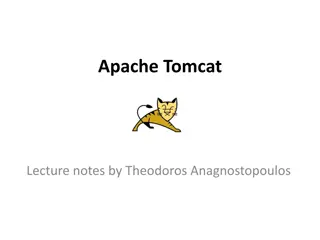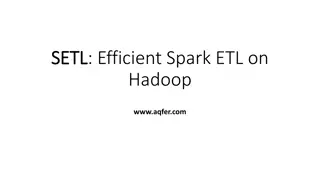Introduction to Apache Pig: Hadoop-Based Distributed Computing
Apache Pig is a powerful tool developed by Yahoo! as a top-level Apache project. It enables non-Java programmers to access and analyze data on a cluster using Pig Latin, a dataflow language. By interpreting Pig Latin, Apache Pig generates MapReduce jobs for efficient data summarization, querying, and analysis. Learn about Pig's data model, Pig Latin basics, data types, execution modes, and more in this comprehensive guide.
Download Presentation

Please find below an Image/Link to download the presentation.
The content on the website is provided AS IS for your information and personal use only. It may not be sold, licensed, or shared on other websites without obtaining consent from the author.If you encounter any issues during the download, it is possible that the publisher has removed the file from their server.
You are allowed to download the files provided on this website for personal or commercial use, subject to the condition that they are used lawfully. All files are the property of their respective owners.
The content on the website is provided AS IS for your information and personal use only. It may not be sold, licensed, or shared on other websites without obtaining consent from the author.
E N D
Presentation Transcript
Apache Pig CMSC 491 Hadoop-Based Distributed Computing Spring 2016 Adam Shook
Objectives Develop understanding of Pig s data model Understand basics of PigLatin
What Is Pig? Developed by Yahoo! and a top level Apache project Immediately makes data on a cluster available to non- Java programmers via Pig Latin a dataflow language Interprets Pig Latin and generates MapReduce jobs that run on the cluster Enables easy data summarization, ad-hoc reporting and querying, and analysis of large volumes of data Pig interpreter runs on a client machine no administrative overhead required
Pig Terms All data in Pig one of four types: An Atom is a simple data value - stored as a string but can be used as either a string or a number A Tuple is a data record consisting of a sequence of "fields" Each field is a piece of data of any type (atom, tuple or bag) A Bag is a set of tuples (also referred to as a Relation ) The concept of a table A Map is a map from keys that are string literals to values that can be any data type The concept of a hash map
Pig Capabilities Support for Grouping Joins Filtering Aggregation Extensibility Support for User Defined Functions (UDF s) Leverages the same massive parallelism as native MapReduce
Pig Basics Pig is a client application No cluster software is required Interprets Pig Latin scripts to MapReduce jobs Parses Pig Latin scripts Performs optimization Creates execution plan Submits MapReduce jobs to the cluster
Execution Modes Pig has two execution modes Local Mode - all files are installed and run using your local host and file system MapReduce Mode - all files are installed and run on a Hadoop cluster and HDFS installation Interactive By using the Grunt shell by invoking Pig on the command line $ pig grunt> Batch Run Pig in batch mode using Pig Scripts and the "pig" command $ pig f id.pig p <param>=<value> ...
Pig Latin Pig Latin scripts are generally organized as follows A LOAD statement reads data A series of transformation statements process the data A STORE statement writes the output to the filesystem A DUMP statement displays output on the screen Logical vs. physical plans: All statements are stored and validated as a logical plan Once a STORE or DUMP statement is found the logical plan is executed
Example Pig Script -- Load the content of a file into a pig bag named input_lines input_lines = LOAD 'CHANGES.txt' AS (line:chararray); -- Extract words from each line and put them into a pig bag named words words = FOREACH input_lines GENERATE FLATTEN(TOKENIZE(line)) AS word; -- filter out any words that are just white spaces filtered_words = FILTER words BY word MATCHES '\\w+'; -- create a group for each word word_groups = GROUP filtered_words BY word; -- count the entries in each group word_count = FOREACH word_groups GENERATE COUNT(filtered_words) AS count, group AS word; -- order the records by count ordered_word_count = ORDER word_count BY count DESC; -- Store the results ( executes the pig script ) STORE ordered_word_count INTO 'output ;
Basic grunt Shell Commands Help is available $ pig -h Pig supports HDFS commands grunt> pwd put, get, cp, ls, mkdir, rm, mv, etc.
About Pig Scripts Pig Latin statements grouped together in a file Can be run from the command line or the shell Support parameter passing Comments are supported Inline comments '--' Block comments /* */
Simple Data Types Type Description int 4-byte integer long 8-byte integer float 4-byte (single precision) floating point double 8-byte (double precision) floating point bytearray Array of bytes; blob chararray String ( hello world ) boolean True/False (case insensitive) datetime A date and time biginteger Java BigInteger bigdecimal Java BigDecimal
Complex Data Types Type Description Tuple Ordered set of fields (a row / record ) Bag Collection of tuples (a resultset / table ) Map A set of key-value pairs Keys must be of type chararray
Pig Data Formats BinStorage Loads and stores data in machine-readable (binary) format PigStorage Loads and stores data as structured, field delimited text files TextLoader Loads unstructured data in UTF-8 format PigDump Stores data in UTF-8 format YourOwnFormat! via UDFs
Loading Data Into Pig Loads data from an HDFS file var = LOAD 'employees.txt'; var = LOAD 'employees.txt' AS (id, name, salary); var = LOAD 'employees.txt' using PigStorage() AS (id, name, salary); Each LOAD statement defines a new bag Each bag can have multiple elements (atoms) Each element can be referenced by name or position ($n) A bag is immutable A bag can be aliased and referenced later
Input And Output STORE Writes output to an HDFS file in a specified directory grunt> STORE processed INTO 'processed_txt'; Fails if directory exists Writes output files, part-[m|r]-xxxxx, to the directory PigStorage can be used to specify a field delimiter DUMP Write output to screen grunt> DUMP processed;
Relational Operators FOREACH Applies expressions to every record in a bag FILTER Filters by expression GROUP Collect records with the same key ORDER BY Sorting DISTINCT Removes duplicates
FOREACH . . .GENERATE Use the FOREACH GENERATE operator to work with rows of data, call functions, etc. Basic syntax: alias2 = FOREACH alias1 GENERATE expression; Example: DUMP alias1; (1,2,3) (4,2,1) (8,3,4) (4,3,3) (7,2,5) (8,4,3) alias2 = FOREACH alias1 GENERATE col1, col2; DUMP alias2; (1,2) (4,2) (8,3) (4,3) (7,2) (8,4)
FILTER. . .BY Use the FILTER operator to restrict tuples or rows of data Basic syntax: alias2 = FILTER alias1 BY expression; Example: DUMP alias1; (1,2,3) (4,2,1) (8,3,4) (4,3,3) (7,2,5) (8,4,3) alias2 = FILTER alias1 BY (col1 == 8) OR (NOT (col2+col3 > col1)); DUMP alias2; (4,2,1) (8,3,4) (7,2,5) (8,4,3)
GROUP. . .ALL Use the GROUP ALL operator to group data Use GROUP when only one relation is involved Use COGROUP with multiple relations are involved Basic syntax: alias2 = GROUP alias1 ALL; Example: DUMP alias1; (John,18,4.0F) (Mary,19,3.8F) (Bill,20,3.9F) (Joe,18,3.8F) alias2 = GROUP alias1 BY col2; DUMP alias2; (18,{(John,18,4.0F),(Joe,18,3.8F)}) (19,{(Mary,19,3.8F)}) (20,{(Bill,20,3.9F)})
ORDER. . .BY Use the ORDER BY operator to sort a relation based on one or more fields Basic syntax: alias = ORDER alias BY field_alias [ASC|DESC]; Example: DUMP alias1; (1,2,3) (4,2,1) (8,3,4) (4,3,3) (7,2,5) (8,4,3) alias2 = ORDER alias1 BY col3 DESC; DUMP alias2; (7,2,5) (8,3,4) (1,2,3) (4,3,3) (8,4,3) (4,2,1)
DISTINCT. . . Use the DISTINCT operator to remove duplicate tuples in a relation. Basic syntax: alias2 = DISTINCT alias1; Example: DUMP alias1; (8,3,4) (1,2,3) (4,3,3) (4,3,3) (1,2,3) alias2= DISTINCT alias1; DUMP alias2; (8,3,4) (1,2,3) (4,3,3)
Relational Operators FLATTEN Used to un-nest tuples as well as bags INNER JOIN Used to perform an inner join of two or more relations based on common field values OUTER JOIN Used to perform left, right or full outer joins SPLIT Used to partition the contents of a relation into two or more relations SAMPLE Used to select a random data sample with the stated sample size
INNER JOIN. . . Use the JOIN operator to perform an inner, equi- join join of two or more relations based on common field values The JOIN operator always performs an inner join Inner joins ignore null keys Filter null keys before the join JOIN and COGROUP operators perform similar functions JOIN creates a flat set of output records COGROUP creates a nested set of output records
INNER JOIN Example DUMP Alias1; (1,2,3) (4,2,1) (8,3,4) (4,3,3) (7,2,5) (8,4,3) DUMP Alias2; (2,4) (8,9) (1,3) (2,7) (2,9) (4,6) (4,9) Join Alias1 by Col1 to Alias2 by Col1 Alias3 = JOIN Alias1 BY Col1, Alias2 BY Col1; Dump Alias3; (1,2,3,1,3) (4,2,1,4,6) (4,3,3,4,6) (4,2,1,4,9) (4,3,3,4,9) (8,3,4,8,9) (8,4,3,8,9)
OUTER JOIN. . . Use the OUTER JOIN operator to perform left, right, or full outer joins Pig Latin syntax closely adheres to the SQL standard The keyword OUTER is optional keywords LEFT, RIGHT and FULL will imply left outer, right outer and full outer joins respectively Outer joins will only work provided the relations which need to produce nulls (in the case of non-matching keys) have schemas Outer joins will only work for two-way joins To perform a multi-way outer join perform multiple two- way outer join statements
OUTER JOIN Examples Left Outer Join A = LOAD 'a.txt' AS (n:chararray, a:int); B = LOAD 'b.txt' AS (n:chararray, m:chararray); C = JOIN A by $0 LEFT OUTER, B BY $0; Full Outer Join A = LOAD 'a.txt' AS (n:chararray, a:int); B = LOAD 'b.txt' AS (n:chararray, m:chararray); C = JOIN A BY $0 FULL OUTER, B BY $0;
User-Defined Functions Natively written in Java, packaged as a jar file Other languages include Jython, JavaScript, Ruby, Groovy, and Python Register the jar with the REGISTER statement Optionally, alias it with the DEFINE statement REGISTER /src/myfunc.jar; A = LOAD 'students'; B = FOREACH A GENERATE myfunc.MyEvalFunc($0);
DEFINE DEFINE can be used to work with UDFs and also streaming commands Useful when dealing with complex input/output formats /* read and write comma-delimited data */ DEFINE Y 'stream.pl' INPUT(stdin USING PigStreaming(',')) OUTPUT(stdout USING PigStreaming(',')); A = STREAM X THROUGH Y; /* Define UDFs to a more readable format */ DEFINE MAXNUM org.apache.pig.piggybank.evaluation.math.MAX; A = LOAD student_data AS (name:chararray, gpa1:float, gpa2:double); B = FOREACH A GENERATE name, MAXNUM(gpa1, gpa2); DUMP B;
References http://pig.apache.org
